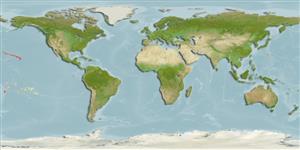>
Mulliformes (Goatfishes) >
Mullidae (Goatfishes)
Etymology: Parupeneus: Latin, parum, parvum = small + Peneus, the name of a river; chrysonemus: Named for its golden yellow barbels..
More on authors: Jordan & Evermann.
Environment: milieu / climate zone / depth range / distribution range
पारिस्थितिकी
समुद्री ड़िमरसल; गहराई सीमा 20 - 183 m (Ref. 54393), usually 60 - ? m. Tropical
Eastern Central Pacific: Hawaii and Johnston islands.
आकार / वज़न / Age
Maturity: Lm ? range ? - ? cm
Max length : 19.6 cm SL पुल्लिंग / अलिंग; (Ref. 54393)
पृष्ठीय रीढ़ (सम्पूर्ण): 8; पृष्ठीय सौफट रेज़ (सम्पूर्ण): 9; ऐनल सौफट रेज़: 7. Diagnosis: Pectoral rays nearly always 16 (4 of 36 specimens with 15 on one side and 17 on the other). Gill rakers 7-8 + 25-28 (total 32-35). Body depth 3.3-4.05 in SL; head length (HL) 2.7-3.05 in SL; eye relatively large, the orbit diameter 4.4 - 5.3 in HL (118-196 mm SL); snout length 1.65-2.1 in HL (snout progressively longer with growth); barbel long 1.1-1.3 in HL; dorsal spine longest in HL; last dorsal rays about equal in length; pectoral-fin length 1.35-1.5 in HL; pelvic fins 1.2-1.4 in HL. White, scale edges narrowly dark, with a red or brown band from front of snout along back adjacent to base of dorsal fins, the scales within band with dark brown edges, and many with a dark brown spot; a red or dark brown stripe from front of snout through eye and broadening as it follows the lateral line; stripe partially interrupted below rear base of second dorsal fin, then ending in a broad slightly oblique bar on caudal peduncle; a vertically elongate dark red or dark brown spot within stripe behind eye in line with posterior margin of preopercle; barbels varying from bright red to yellow or mixed red and yellow; membranes of first dorsal fin red; second dorsal fin red basally, the outer half with narrow irregular pale yellow and pale blue bands separated by dark reddish lines; anal fin with similar bands on all of fin; caudal fin mainly yellow, usually with small white spots basally; pelvic fins largely red. Specimens from the deep water are entirely red without upper band and lateral stripe; a dark red spot behind eye; fins colored as in shallower-water fish except caudal fin more red (Ref. 54393).
Found over sand (Ref. 58302). Generally found at depths deeper than 60 meters (Ref. 54393).
Life cycle and mating behavior
परिपक्व अवधि | पुनरुत्पत्ति | मछलीऔ का अंडे देना | अंडे | Fecundity | लार्वा
Randall, J.E., 2004. Revision of the goatfish genus Parupeneus (Perciformes: Mullidae), with descriptions of two new species. Indo-Pac. Fish. (36):64 p. (Ref. 54393)
IUCN Red List Status (Ref. 130435)
Threat to humans
Harmless
Human uses
अधिक जानकारी
आम नामउपशब्दचपायचयपरभक्षीईकोटोकसीकोलौजीपुनरुत्पत्तिपरिपक्व अवधिमछलीऔ का अंडे देनाSpawning aggregationFecundityअंडेEgg development
संदर्भजलीयकृषिजलीयकृषि रूपरेखाखींचआनुवंशिकीElectrophoresesहैरेटिबिलटीबीमारीप्रक्रमणNutrientsMass conversion
सहयोगीयोतस्वीरेStamps, Coins Misc.ध्वनिसिगुयटिरारफ्तारतैरने के प्रकारगिल क्षेत्रOtolithsदिमागदृष्टि
साधन
Special reports
Download XML
इंटरनेट स्रोत
Estimates based on models
Preferred temperature (Ref.
123201): 7.5 - 20.2, mean 10.1 °C (based on 7 cells).
Phylogenetic diversity index (Ref.
82804): PD
50 = 0.5000 [Uniqueness, from 0.5 = low to 2.0 = high].
Bayesian length-weight: a=0.01202 (0.00556 - 0.02601), b=3.10 (2.93 - 3.27), in cm total length, based on LWR estimates for this Genus-body shape (Ref.
93245).
Trophic level (Ref.
69278): 3.4 ±0.4 se; based on size and trophs of closest relatives
लौटाव (Ref.
120179): ऊंचा, न्यूनतम जनसंख्या दुगनी समय अवलागत 15 महीने। (Preliminary K or Fecundity.).
Fishing Vulnerability (Ref.
59153): Low vulnerability (14 of 100).
Nutrients (Ref.
124155): Calcium = 131 [47, 384] mg/100g; Iron = 0.651 [0.305, 1.675] mg/100g; Protein = 17 [14, 20] %; Omega3 = 0.249 [0.125, 0.526] g/100g; Selenium = 91.3 [36.1, 252.8] μg/100g; VitaminA = 69.4 [12.9, 332.3] μg/100g; Zinc = 0.606 [0.337, 1.242] mg/100g (wet weight);
